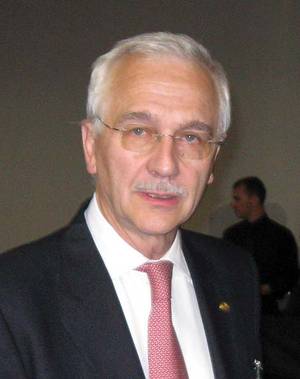PARIS – The notable safety of the everolimus-eluting coronary stent in a prospective, randomized trial with about 1,500 patients with acute ST elevation myocardial infarctions may change the stent choice that many interventional cardiologists make when treating these patients.
Until now, interventionalists have often shied away from placing a drug-eluting coronary stent on an emergency basis in acute myocardial infarction (MI) patients undergoing primary percutaneous coronary intervention because it is often hard to assess the future ability of these patients to remain on dual-antiplatelet therapy for a year to cut their risk of stent thrombosis.
The new results, obtained in an all-comer trial in which 70% of presenting acute ST elevation MI (STEMI) patients qualified to enter the trial, showed that dual-antiplatelet therapy compliance ran 95% during the 1-year follow-up and that patients who received an everolimus-eluting stent had a substantially reduced stent thrombosis rate, compared with patients who received a bare metal stent, Dr. Manel Sabaté reported at the annual meeting of the European Society of Cardiology.
"The findings support the safety and efficacy profile of the Xience V [everolimus-eluting coronary] stent in a widely representative cohort of patients presenting with STEMI," said Dr. Sabaté, chief of cardiology at the Hospital Clinic in Barcelona.
"The results of this trial are reassuring. With first-generation drug-eluting stents [sirolimus- and paclitaxel-eluting stents], there was concern about stent thrombosis in STEMI. These data say that the everolimus-eluting stent is even safer than a bare metal stent. For the first time, you can feel reassured that you can implant a drug-eluting stent in patients with STEMI using the same criteria as in patients without acute coronary syndrome," Dr. Sabaté said.
In the EXAMINATION (Clinical Evaluation of Xience-V Stent in Acute Myocardial Infarction) trial during the first year of follow-up, definite or probable stent thrombosis occurred in 0.90% of patients who received an everolimus-eluting stent, and in 2.35% of those who received a bare-metal, cobalt-chromium stent, a statistically significant difference for this prespecified, secondary end point of the study. The study’s primary end point, the 1-year composite rate of all-cause death, MI, or any revascularization, occurred in 14.4% of the patients who received a bare-metal stent and in 12% of those who received an everolimus-eluting stent, a difference that did not achieve statistical significance.
Many cardiologists who heard the results viewed them as practice changing, although at least one expert cautioned that, strictly speaking, the secondary findings should be considered hypothesis generating only because the study failed to prove its primary end point.
"The trial was not powered for stent thrombosis" as a primary end point, commented Dr. William Wijns, a cardiologist at the Cardiovascular Research Center in Aalst, Belgium. Current treatment recommendations from the European Society of Cardiology say that an interventionalist could use a drug-eluting stent to treat a STEMI to reduce the patient’s risk for restenosis, "provided you feel comfortable with the patient’s [future] use of dual-antiplatelet therapy," he said in an interview.
Often with STEMI patients, that comfort level does not exist because "you can’t interrogate the patient and you don’t know the patient’s history, so you have to be cautious about drug-eluting stents." In addition, there was concern about stent thrombosis. "That’s where this result will change the perception," he said. "I cannot say the results change the evidence, because the trial did not reach its primary end point. A rigorous analysis would say this trial is only hypothesis generating, but some negative trials do influence practice. And it also comes as yet another piece of evidence regarding the new generation drug-eluting stents, and this brand of stent in particular. This is another positive signal" for the safety of the everolimus-eluting stent. "The signal is a reduced risk with the second-generation drug-eluting stent. It’s a fantastic opportunity," Dr. Wijns said.
Other experts were less guarded in foreseeing important treatment implications from the results.
"The data are very convincing," commented Dr. P. Gabriel Steg, a professor of cardiology at the University of Paris and director of the coronary care unit at the Bichat-Claude Bernard Hospital, also in Paris. "The results "will probably change the view of the interventional community and may possibly change the guidelines with respect to using a drug-eluting stent in this setting. To have a result with confidence, we’ll need a large trial, but this smaller trial points in a reassuring direction. What I like about the trial is its generalizability, because they enrolled 70% of their [STEMI] patients. The results are only from 1 year, and we need to remember that some of the concerns about drug-eluting stents in STEMI patients relate to late events. But the results are very reassuring in this setting for up to 1 year."



